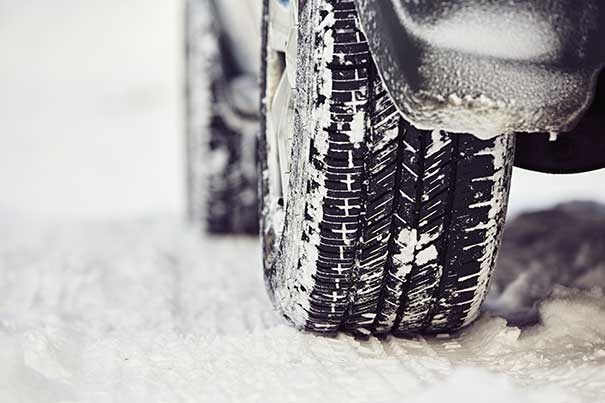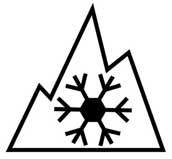
Winter tires are designed for enhanced performance on icy, snowy roads.
Image Credit: Adobe Stock
January 13, 2020 - 12:00 AM
Even if you drive a 4WD or AWD, your tires are what contact the road and determine control. Winter tires are designed for enhanced performance on icy, snowy roads. If you plan to travel outside the Lower Mainland, winter tires are required on most highways. Signs are posted throughout the province designating winter tire and chain-up routes. As enforced by officials, motorists who are not compliant may be turned away from driving on these routes, or fined. Most importantly, the safety of you and your family is at risk if you drive on unsafe tires through the inclement weather of our winter season.

Severe Weather Mark
Image Credit: Adobe Stock
The Severe Weather Mark
Look for the severe service mountain snowflake symbol to check if your tires are safe for driving through the winter months. If your tire bears this symbol and the tread still measures +4 mm your tires are designated safe to drive in winter conditions. If you have any doubts about the condition of your tires, talk to a tire specialist.
-
3-Season tires are designed for a smooth, quiet ride for driving in the spring, summer and fall. 3-Season tires lose their grip at -7, so are not a safe choice for driving in the winter. They do not bear the severe weather symbol, so are illegal in the winter on some BC highways.
-
All-Weather or all-season tires are safe for mild winter conditions and all-season use. All-season tires bear the severe symbol of a snowflake within a mountain (M/S). They also get you safely through the warmer months of spring through autumn. An all-season tire with aggressive tread design and siping (tiny slits in the tire surface) provides stability by biting snow and pushing away water and slush.
-
Performance tires have enhanced cornering response and control at high speeds from spring to fall. Performance tires are made from rubber compounds, which are softer than all seasons, so the tread wears faster. They are not suitable for safe winter driving. They do not bear the severe weather symbol, so are illegal in the winter on some BC highways.
-
Winter tires stay flexible when the temperature dips below zero, allowing them to grip the road through inclement weather. Look for the mountain and snowflake (M/S) symbol that marks winter tires recommended for driving from October 1 to March 31. Remember to use four matched tires for driving coordination when braking, accelerating and cornering.
Studded Tires Versus Winter Tires
Studded tires are embedded with metal studs designed to dig into the ice, providing extra traction. When the road surface is not covered with ice, these studs can dig into pavement and cause damage. Although studded tires can handle nasty road conditions, technology has improved winter non-studded tires for driving in extreme conditions.
Modern snow tires are flexible in freezing temperatures, allowing better traction on ice, slush and snow. A feature of well designed winter tires are thousands of tiny slits in the tread pattern, or sipes, for tighter control with corners and braking.
Ask Your Tire Expert
Ask a tire expert for information on the safest choice for your vehicle, local weather conditions and driving style. Winter tires are recommended for driving from October 1 to March 31 in BC if you live outside the Lower Mainland.
Drive Safe!
ADVERTISER'S LOGO AND LINK TO WEBSITE HERE
News from © iNFOnews, 2020